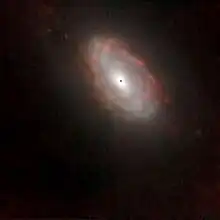NGC 23
NGC 23 is a spiral galaxy located in the northern constellation of Pegasus, around 173.5 megalight-years distant from the Milky Way.[3] It was discovered by William Herschel on 10 September 1784. In the Webb Society Deep-Sky Observer's Handbook,[6] the visual appearance of NGC 23 is described as follows:
Bright, extended ellipse; a bright nuclear structure is noticeably elongated; two weak spiral enhancements emerge from opposite sides of the nucleus, one curving towards a bright star attached on the south end. The galaxy is likely interacting with NGC 9.
| NGC 23 | |
|---|---|
 NGC 23 by HST | |
| Observation data (J 2000.0 epoch) | |
| Constellation | Pegasus |
| Right ascension | 00h 09m 53.411s[1] |
| Declination | +25° 55′ 25.46″[1] |
| Redshift | 0.015231[2] |
| Heliocentric radial velocity | 4,568 km/s[3] |
| Distance | 173.5 Mly (53.21 Mpc)[3] |
| Apparent magnitude (V) | 11.9 mag |
| Absolute magnitude (V) | -21.85 |
| Characteristics | |
| Type | SBb[4] |
| Apparent size (V) | 1.9′ × 1.4′ |
| Other designations | |
| LEDA 698, UGC 89, Mrk 545, PGC 698, GC 9.[2][5] | |
The shape of this galaxy is described by its morphological classification of SBb, which indicates it is a barred spiral (SB) with spiral arms that are moderately tightly wound (b).[4] It is a luminous infrared galaxy with star-forming clumps.[7]
In 1958, supernova SN 1955C was discovered in NGC 23 using the Hale Telescope. On a photographic plate taken 23 October 1955 (three years prior), a bright star with a visual magnitude around 16 was located 10″ to the north and 10″ east of the galactic center. It was not present on a plate taken 60 days prior.[8]
References
- Skrutskie, Michael F.; Cutri, Roc M.; Stiening, Rae; Weinberg, Martin D.; Schneider, Stephen E.; Carpenter, John M.; Beichman, Charles A.; Capps, Richard W.; Chester, Thomas; Elias, Jonathan H.; Huchra, John P.; Liebert, James W.; Lonsdale, Carol J.; Monet, David G.; Price, Stephan; Seitzer, Patrick; Jarrett, Thomas H.; Kirkpatrick, J. Davy; Gizis, John E.; Howard, Elizabeth V.; Evans, Tracey E.; Fowler, John W.; Fullmer, Linda; Hurt, Robert L.; Light, Robert M.; Kopan, Eugene L.; Marsh, Kenneth A.; McCallon, Howard L.; Tam, Robert; Van Dyk, Schuyler D.; Wheelock, Sherry L. (1 February 2006). "The Two Micron All Sky Survey (2MASS)". The Astronomical Journal. 131 (2): 1163–1183. Bibcode:2006AJ....131.1163S. doi:10.1086/498708. ISSN 0004-6256. S2CID 18913331.
- "NASA/IPAC Extragalactic Database". Results for NGC 0023. Retrieved 4 May 2010.
- Tully, R. Brent; et al. (2016). "Cosmicflows-3". The Astronomical Journal. 152 (2): 50. arXiv:1605.01765. Bibcode:2016AJ....152...50T. doi:10.3847/0004-6256/152/2/50. S2CID 250737862.
- García-Lorenzo, B.; et al. (January 2015). "Ionized gas kinematics of galaxies in the CALIFA survey. I. Velocity fields, kinematic parameters of the dominant component, and presence of kinematically distinct gaseous systems". Astronomy & Astrophysics. 573: 43. arXiv:1408.5765. Bibcode:2015A&A...573A..59G. doi:10.1051/0004-6361/201423485. S2CID 55475658. A59.
- "NGC 23". SIMBAD. Centre de données astronomiques de Strasbourg. Retrieved 19 March 2020.
- Jones, K. G. (1981). Webb Society Deep-Sky Observer's Handbook. Enslow Publishers. ISBN 978-0894901348.
- Larson, K. L.; et al. (January 2020). "Star-forming Clumps in Local Luminous Infrared Galaxies". The Astrophysical Journal. 888 (2): 92. arXiv:1911.09367. Bibcode:2020ApJ...888...92L. doi:10.3847/1538-4357/ab5dc3. S2CID 208202084. 92.
- Sandage, Allan (April 1959). "A Supernova in NGC 23". Publications of the Astronomical Society of the Pacific. 71 (419): 162. Bibcode:1959PASP...71..162S. doi:10.1086/127353.
External links
 Media related to NGC 23 at Wikimedia Commons
Media related to NGC 23 at Wikimedia Commons- NGC 23 on WikiSky: DSS2, SDSS, GALEX, IRAS, Hydrogen α, X-Ray, Astrophoto, Sky Map, Articles and images